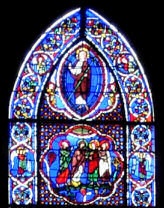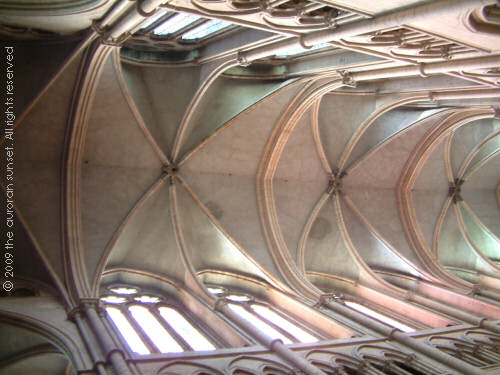

|
index
introduction
history
cathedral construction
and dimensions
stained glass
astronomical clock
the organs
to see in the
cathedral
background
facts
The cathedral
of St Jean was called La Primatiale because, from 1079 the Archbishop
of Lyon was Primate of the Gauls, exercising judicial supremacy over the
main archbishops of France. The name La Primatiale continues
even now, though the archbishops of Sens and Paris and their provincial
dioceses have not been subject or subordinate to the Archbishopric of
Lyon since the French Revolution.
Romanesque and Gothic in its style, Lyon
cathedral reflects in its architecture and styles both the story of the
city of Lyon and the very long building process, which took over four
centuries. |
|
history
- 1175 or after,
Archbishop Guichard (1165-1181):
- started construction, in Romanesque style, of the cloister wall,
together with the walls of the apse,
the two lateral chapels and the transept.
Cathedral construction was on fields reclaimed from the banks of the
river Saône.
- Jean Bellesmains (1182-1193), successor to Guichard:
- opened both lateral chapels of the chancel to worship
built up apse and chancel to the triforium
started work on the west side.
- Archbishops Renaud de Forez (1193-1226)
and Robert d'Auvergne (1226-1234) oversaw:
- construction of the eastern arches of the nave and of the triforium
of the transept
building, in Gothic style, of vaults of apse and transept
construction of both eastern tower and first four bays of the nave (two
double bays) with their sexpartite vaults.
-
- 1245, completion of stained glass windows in the
chancel and both rose windows in the transept.
- These had been given by Dean Ernout.
13th Ecumenical Council held in the cathedral after Pope Innocent 4th had fled to
Lyon from the besieged city of Rome.
- 1274, 14th
Ecumenical Council convened by Pope Gregory 10th and
held in the cathedral
- 1316, coronation of Pope John XXII
- End of the 13th century to first third of the 14th century
- the other four bays (two double bays) of nave and lower section of
the facade completed.
- Archbishop Pierre de Savoie (1308-1332)
- commanded production of 280 medallions for the western facade, illustrating
episodes from the Old and New Testaments.
- The towers of the western facade built by architect Jacques de Beaujeu.
Archbishops Jean de Talaru (1375-1389) and Philippe
de Thurey (1389-1415):
- oversaw completion of sexpartite vaults of last bays and facade
rose window (1392)
- End of the 14th century
- Henry de Nivelle, stained-glass master, directed production of western/facade rose window.
- 15th century, top section of the facade and towers
completed,
1481, statue of God the Father placed at gable top.
- End of 15th century to beginning of 16th century
- The chapel de Bourbon is built on the south side, in flamboyant Gothic
style.
(chapel named after Cardinal de Bourbon and his brother Pierre de Bourbon,
son-in-law of Louis XI, who ordered its construction).
- 1562, the cathedral is devastated by Calvinist troops
headed by Baron des Adrets during the Religion wars.
- All statues in the alcoves of the facade destroyed
All angels in the three portals decapitated.
- 1600, 13th December
- King
Henri IV of Navarre visited to Lyon, so he could meet his fiancée,
the Italian Marie de Medici, on her way from Marseille.
Henri approved of Marie at first sight, and married her straight away
in Lyon cathedral.
- 18th century
- Medieval stained glass windows in nave and in tympanum of main portal
destroyed on Canons’ orders in order to enable the passage of
processions.
- 1789 on, during the Revolution
- cathedral received further deteriorations.
Between 1791 and 1793, Bishop Lamourette ordered modifications to the
chancel, in particular the destruction of the rood screen [that divides
the choir from the nave].
- 1845 to 1861
- Restoration works by architect Tony Desjardins, intended to complete
building unfinished by 15th-century master-builders. Works proposed
included roof raising, spires on eastern towers and a new interior decor,
in order to give a similar appearence to classical Île-de-France
cathedrals.
- 1861, high-pitched
roof completed, and starts a long debate continuing to the 1880s,
- with archaeologists opposing architects on restorations as proposed
inViollet Le-Duc’s
theories that had little respect for a building’s original physiognomy.
- 1935-1936, the chancel is restored in its medieval
layout.
- September 1944, Liberation of Lyon
- All stained glass windows that had not been removed were destroyed.
Fortunately, the oldest glass was put away safely.
cathedral construction and dimensions
The site originally chosen for the cathedral
was too small. The site actually used was available in good part because,
being reclaimed from the river Saöne, it was not very solid. Thus
today, the cathedral lists slightly to the south, with cracks in the transept
and the choir.
The building is partly built with blocks
recovered from Roman monuments that had collapsed in the ninth century,
particularly from the old forum. When the building of the cathedral finished
at the end of the 15th century, it had become notable for its flamboyant
Gothic features. The facade, completed in 1480, was cleaned in 1982.
- Length
- The cathedral: 80 metres/262 feet long
including choir: 20 metres/66 feet long
- Width
- Total aisle width: 26 metres/85 feet
including main nave: 19.3 metres/63 feet wide
- Height
- Nave arches: 32.5 metres/106.6 feet
choir arches: 24.3 metres/79.7 feet.
Facade towers: 44 metres/144 feet
These are topped by an oak cross 4 metres/13 feet high.
- Bell tower (Burgundy tower)
- A Burgundy oak frame supports 6 bells, the largest
weighing between 8,000 and 9,000 kg /17,600 and 19,800
pounds and measuring 2.07 metres/6.8 feet in diameter!
The cathedral’s interior chronicles
the history of its construction. The apse and the choir are Romanesque,
but as the visitor moves to the front (west) entrance, the construction
becomes more Gothic.

Floor plan of Lyon cathedral. The thin lines mark
the ribs of the roof’s vaulting.
|

Panel showing the history of the
Redemption, twelfth century
advertising
disclaimer

on first arriving in France
- driving

France is not England
Marianne - a French national symbol,
with French definitive stamps
the calendar of the French
Revolution

the 6th
bridge at Rouen: Pont Gustave Flaubert,
new vertical lift bridge

Futuroscope
Vulcania
the French umbrella &
Aurillac
the forest
as seen by francois mauriac, and today 
places and
playtime
roundabout art of
Les Landes
50 years old: Citroën DS
the Citroën 2CV:
a French motoring icon
la
belle époque 
Pic du
Midi - observing stars clearly, A64 
Carcassonne,
A61: world heritage fortified city 
Grand Palais, Paris
Marianne - a French national symbol,
with French definitive stamps
the calendar of the French
Revolution
le pique-nique
Hermès scarves

bastide towns
mardi gras! carnival in Basque
country
what a hair cut! m & french pop/rock
country life in France: the poultry
fair
short biography of Pierre
(Peter) Abelard

|
| Chapels, as numbered
in plan above: |
| I Chapel
Saint-Pierre/ Chapel of the Virgin |
II Chapel
Saint-Thomas |
III Chapel
of the Annunciation |
| IV Chapel Saint-Michel |
V Chapel Saint-Denis
& Austregesille |
VI Chapel Notre Dame
& Saint-Jean-Baptiste |
| VII Chapel of the
Fonts |
VIII Notre-Dame of the Haut-Don
/ the Cross |
IX La Madeleine |
| X Chapel of Saint-Raphael |
XI Chapel of Saint-Sepulcre |
XII Chapel of
the Bourbons |
Stained
glass
The Lyonnaise region is less
rich than other regions in old stained glass. However,
Lyon cathedral retains a complete and strong run of very
lovely specimens from the twelfth to the fifteenth century:
in the apse, the lateral chapels of the choir and the
arms of the cross (the transepts).
In the Chapel of the Virgin
[originally called the chapel of St. Peter/Saint-Pierre],
there is stained glass dating from the end of the twelfth
century. The earliest glass, the chapel’s west window,
shows the lives of St. Peter and St. Paul.
The next oldest stained glass
at Lyon are the thirteenth century windows of the lower
level of the apse. There are seven large bays containing
seven brightly lit panels, centred around a panel on the
Redemption, shown on the left.
The central panels of the
Redemption window each have supporting, smaller panels
on each side that develop each central scene and show
the mystical significance. The smaller subjects show either
events from the Old Testament or symbolic animals. Traditionally,
mankind’s sins are redeemed/cancelled out by the
death of Jesus.
The panels show, from bottom
to top. In the list below, for each entry, the central
medallion is decribed first, then the left medallion,
and lastly the right medallion:
- The Annunciation, with the unicorn, symbol of the
Incarnation of Jesus and Isiah showing the text: Ecce
Virgo [concipiet] - here the Virgin conceived;
- The Nativity, with the burning bush and the fleece
of Gideon;
- The Crucifixion, with the sacrifice of Abraham and
the bronze Serpent;
- The Resurrection, with Jonah expelled by the whale
and St. Epiphane’s lion of Phisiologus;
- Mary, John and two other apostles watchng the Ascension;
with a symbolic eagle showing the sun in its claws,
and Charadrius (or Calandre) turning its head towards
a dying person to heal them, the flying into the sun’s
rays (the eagle is, apparently, te only bird capable
of flying straight to the sun without being blinded);
- The other apostles contemplating Jesus going up to
heaven, with two angels holding banners;
- In the almond-shaped peak, Christ trimphant carrying
his cross, on each side adored by an angel.
During a first restoration in 1844, the order of the
panels was unfortunately inverted, and in 1904 when the
lead was again renewed, they were remained in this disorder.
However, more recently, the panels have been returned
to the correct progression.
- The founding saints of the Church of Gaules - St.
Pothin, St. Irene, St. Polycarpe
- Life of John the Evangelist
- Life of John the Baptist. Glass presented by archbishop Renaud de Forez
- the Redemption (central window - here, to the left),
giving a resumé of the redemption of the world.
The fourteen small subjects to each side show events
in the Old Testament or symbolic animals.
- Life of St Etienne
- Childhood of Jesus, the Virtues and Vices
- Resurrection of Lazarus
In the upper part of the
choir, the cleristory presents a sucession of prophets.
Unfortunately, they have been over-restored..
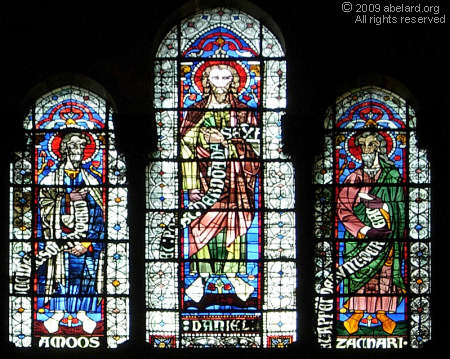
In the clestory of the apse,
are depicted the twelve apostles, all over restored, except
for Peter and Paul. In the centre is Jesus and Mary, crowned
and sitting on two thrones, with their feet on the arms
of the town of Lyon. This window dates from the very end
of the 13th century.
There are several rose windows
in the Notre-Dame cathedral.
- High above the choir,
the north rose [illustrated below] is small, containing
eight medallions, of which only the top three are very
old.
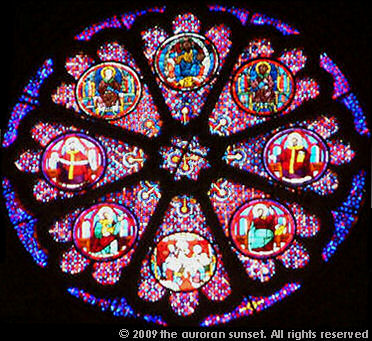
- The
western rose at the cathedral entrance [illustrated
below] dates from 1392, and shows the Easter Lamb surrounded
by the life of saint Jean-le-Baptiste, and that of saint
Etienne, the saints for whom this cathedral is named.

The west rose window at Lyon cathedral
Above: from the exterior
Below: from inside the cathedral
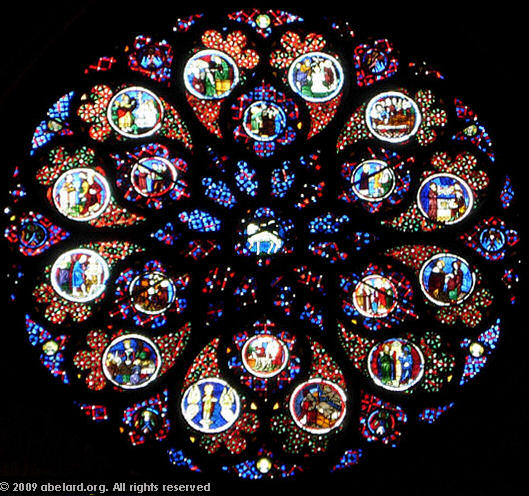
- Northern
transept rose [shown just below], dates from the 18th
century. In the centre, an allegory of the triumphant
Church holding the cross and chalice. Occupying two
concentric rows of twelve medallions are the Good and
the Bad angels, kneeling in adoration before Jesus sitting
at the summit, else falling head first. In one of the
outside lobes, on the west and just below the horizontal
line, is the donor of the glass, Arnoud de Colonges,
Canon from 1241 to 1250, holding the rose he gave to
the cathedral. An inscription names him: Li doïens
Ernous me fecis (sic) facere.
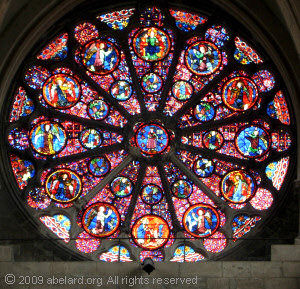
- Southern transept [méridionale]
rose, dates from the 18th century [shown just below].
In the centre, the Holy Spirit. In the inner ring of
twelve small medallions are small angels holding parchments
rolls and small pots. the exterior ring contains twelve
medallions, representing, to the right, the Original
Sin in the Earthly Paradise, and to the left, Redemption,
from the Annunciation to the Resurrection.
The colour of stained glass
of each window is appropriate to its position. The South
transept windows have colder, violet and green colours
to offset the heat of the sun, while those in the North
transept are predominately warm and red.
- In
the 15th-century chapel of the Bourbons [XII], there
is a late Flamboyant spiral rose window. There are also
two large bays of which the upper parts still have their
orginal glass.
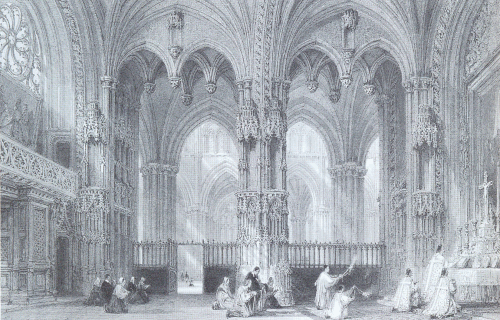
19th century engraving of the Chapel
of the Bourbons, with Flamboyant spiral rose window on
the left
 Some
stained glass windows were destroyed by the German occupation
and have Some
stained glass windows were destroyed by the German occupation
and have
been replaced by modern glass, like the example
to the left.
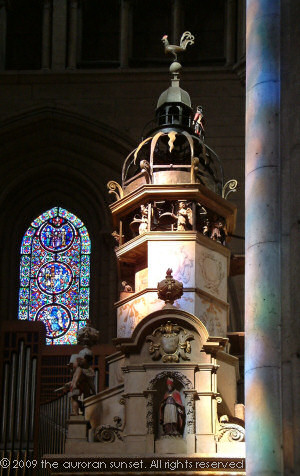 Astronomical
clock Astronomical
clock
Built by N. Lippius of Basle,
this clock was finished in 1598. The mechanism is wrought
iron, and includes a perpetual calendar and a religious
calendar - the clock can calculate the dates of all saints’
feast days up until 2019, as well as the position of the
stars above Lyon. The perpertual calendar is accurate
until 3008! There is also an oval minute face. Several
moving figures [automatons] ‘come to life’
momentarily at noon, two and three o’clock. The
automatons include animals and a scene depicting the Annunciation.
Height: 9.35 metres/30.6 feet
Width: 2.2 metres/7.2 feet
organs
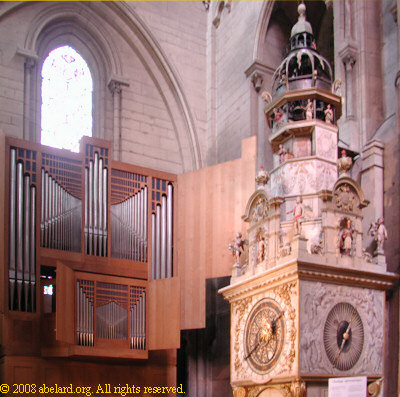 There are two organs. The
current main organ was built in 1841 by the company Daublaine
et Callinet with the neo-gothique style case designed
by Bossanet et revised by Desjardins. From 1852, organ
builder Pierre-Alexandre Ducroquet worked on the instrument. There are two organs. The
current main organ was built in 1841 by the company Daublaine
et Callinet with the neo-gothique style case designed
by Bossanet et revised by Desjardins. From 1852, organ
builder Pierre-Alexandre Ducroquet worked on the instrument.
The transept organ was built
in 1974 by Jürgen Ahrend, who built the organ for
the Church of Reconciliation, Taizé. This organ
is based on the idea of a form that is both strong and
unified. It was designed according to principles of French
classical organ building.This organ was designed and built
entirely in Leer (in East Friesland). In 1979, it was
disassembled and stored in a barn at Blondiaux Manziat
(Bresse). In 1981, it was installed in the church of the
monastery Cluniac Payerne (Switzerland), and since 1996,
installed in the north transept of Lyon cathedral.
Left: The transept organ, with the astronomical clock
to see
in the cathedral
- Chapel of the Bourbons, south aisle
- Flamboyant architecture and rose window of the late
15th century
- Front portals have medallions depicting the Creation,
the life of St. John, and the signs of the zodiac.
Stained glass in upper row of windows dates from 1501.
- Choir
- 18th century stalls: when the choir was refurnished
after the revolution, these stalls were purchased from
the abbey at Cluny, which had put them on sale.
- High altar
- two crosses commemorating the union of the Greek and
Latin Churches - the Union of Lyons, proclaimed at the 14th
Ecumenical Council in 1274.
- Entrance to sacristy, south transept
- fine 18th century grillwork
- Sculptures,
- distributed throughout the entire building and on
exterior doorways
| Background
facts |
Lyon  |
approximate population : 480,660
average altitude/elevation : 175 m
- cathedral dimensions
- length
- 80 metres/262 feet long
choir: 20 metres/66 feet long
- width
- total aisle width: 26 metres/85 feet
main nave: 19.3 metres/63 feet wide
- height
- nave arches: 32.5 metres/106.6 feet
choir arches: 24.3 metres/79.7 feet.
facade towers: 44 metres/144 feet
(These are topped by an oak cross 4 metres/13 feet high.)
- bell tower (Burgundy tower)
- A Burgundy oak frame supports 6 bells, the largest
weighing between 8,000 and 9,000 kg /17,600 and 19,800
pounds and measuring 2.07 metres/6.8 feet in diameter!
-
|

- Some reference keywords/tags:
- cathedrale,Lyon Cathedral,Cathedrale,Primatiale,photos,image,images,photograph,picture,pics,France,Gothic
architecture,statue,iconography,symbol,Amiens,Poitiers,Bourges,Tours,Beauvais,Rouen,Notre-Dame
de Paris,Chartres,Dax Cathedral,
end
note
- A city’s
population varies, depending on what is counted as the
population. Thus, for Lyon, one can find the following
data :
city : 480,660
urban area : 1,422,331
conurbation : 1,757,180.
|








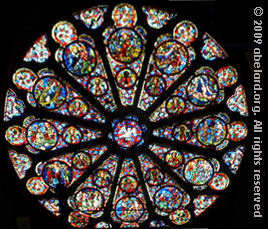

![]()


